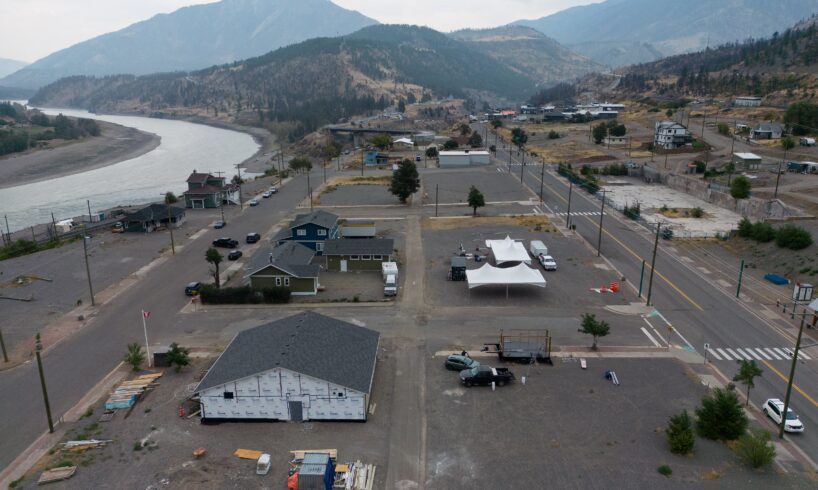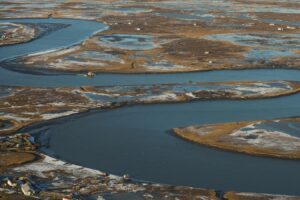
Open this photo in gallery:
A house under construction in Lytton, B.C., June, 2024. Proposed updates to B.C.’s Heritage Conservation Act have become a flashpoint in the province, with critics, including municipal politicians and real-estate actors, warning of unintended consequences if the act is passed as is.DARRYL DYCK/The Canadian Press
Nearly two decades ago, a cave regarded as a sacred site by the Songhees Nation was destroyed to make way for the Bear Mountain resort development near Victoria.
There were no tangible Indigenous artifacts at the site, in an area called Spaet by the Songhees, so the provincial archeologists involved said there was no obligation to preserve it under B.C.’s existing Heritage Conservation Act of 1996.
The decision outraged Indigenous groups at the time.
“Mountains such as Spaet continue to be significant to the Indigenous people including the Salish people,” wrote Songhees lands manager Cheryl Bryce shortly after the destruction, in archeological journal The Midden. “The stories and practices are passed down to individuals within a family for many reasons, one being to protect the ancestral and cultural connection to the land.”
Under a proposed new Heritage Conservation Act, that cave and other places like it in B.C. – which have been shown through oral histories, songs, or art to be a significant part of Indigenous heritage – would get protection.
Opinion: A land-claims nightmare is emerging in B.C.
But the draft legislation has also turned into a flashpoint in the province, with business groups, municipal politicians, real-estate actors and land-use lawyers warning that the proposed rules will set off a flood of unintended consequences if the act is passed as is.
Besides the debate over the new definition for what is or isn’t potential heritage, critics are warning the new act is riddled with vague language about how decision-making will be shared, and where the money will come from to assess sites as per the expanded requirements.
The proposed legislation also doesn’t make it clear what cities should do about potential development proposals where two different nations have a claim over the land.
“The lack of clarity is going to bring some legal troubles,” said Union of BC Municipalities president Cori Ramsay, who is also a city councillor in Prince George. “There are serious information gaps in the materials presented to date.”
Yet, a submission to the province from the union last week said that the existing act does need to be updated because of a plethora of problems that have emerged over the past three decades.
For instance, the union highlighted that it currently takes three separate permits from the province to authorize building on a potential heritage site. It also said that First Nations don’t have enough involvement in the process, and that there were already not enough provincially designated archeologists to keep up with demand. The submission asserted that there is no co-ordination between the province and local governments that are supposed to be regulating land use.
One change in the proposed act that the municipalities’ group did support was the requirement to consider “intangible heritage” – based on stories, songs, or traditions – into decision-making. It’s a kind of recognition from the province that has already been awarded to areas such as Vancouver’s Chinatown, for instance.
But groups including the Business Council of B.C. and the Independent Contractors and Businesses Association have warned that the idea of intangible heritage values risks years of complicated debates over development sites.
“It is impossible to regulate what cannot be seen or touched,” wrote the contractors association in its submission to the province.
Attempting to apply permitting rules to intangible heritage “is certain to be a recipe for endless debate, conflict, and litigation,” the association said. “Builders cannot be expected to design, price, or plan projects based on undefined, subjective, and non-physical criteria.”
Last week was supposed to be the final deadline for extended consultations on the draft act. Premier David Eby said local politicians’ concerns will be taken seriously, but there has been no indication of whether the proposed legislation will be rewritten.
The largely negative reaction is also provoking concern from First Nations representatives, who fear the current climate of uproar in B.C. over private property rights and land claims is going to spill over into discussions about the new act, stalling needed changes.
B.C. Insider: The impact of the Cowichan Tribes decision is already reverberating
“We’re on the cusp of getting something built so we don’t have to go to the courts,” said Robert Phillips, a member of the First Nations Leadership Council.
He said the new act creates more transparency about how B.C. historic sites are evaluated and treated, as well as giving First Nations a more direct role.
More than once in recent years, local governments or the province have stepped in to protect historic Indigenous sites.
The province paid $5.45-million for an islet near Salt Spring Island in 2015, under the then-B.C. Liberal government, and had a partially constructed house demolished to protect the burial site on the island. Nearby First Nations groups had tried for three years to stop the construction before the government stepped in.
The province also bought 36 hectares of land near Sumas First Nation for an undisclosed price in 2024, a decade after a private owner trying to build a $40-million farm-equipment dealership had his project killed, when it was discovered the land included a burial ground, as well as a sacred site called Lightning Rock.
The issues with the original act also came to a head as the village of Lytton tried to rebuild itself after a devastating fire in the summer of 2021.
Lytton is one of the oldest human settlements in North America, meaning the ground there contains several artifacts. For instance, a former burial site sat directly under one of the town’s single-family homes for years.
Lytton Mayor Denise O’Connor said the process for getting all of the town’s land reviewed by provincially authorized archeologists was time-consuming and confusing, while the costs for people hoping to rebuild were huge.
Ms. O’Connor said she ended up paying $20,000 for an archeologist to assess her own property, which was filled with “flakes” – pieces that had chipped off from the stone tools of long-vanished peoples. She and others with similar bills were eventually reimbursed by the province.
Ms. O’Connor has been given permission to rebuild on her property, as has the person who owned the property with the burial site.
“The legislation was written in 1996 for things like highways and pipelines,” she said.





